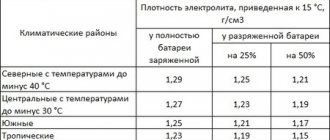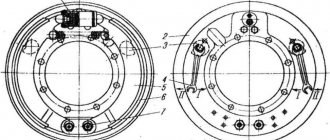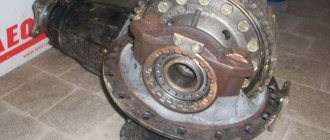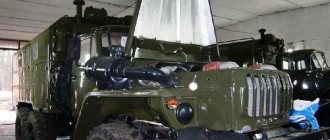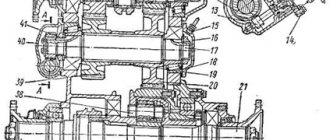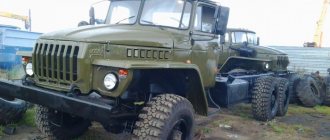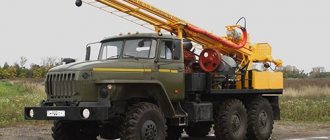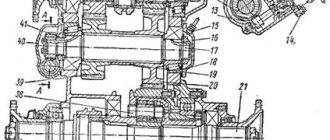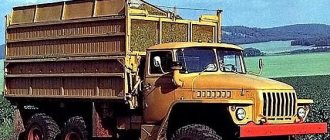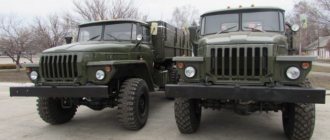The car frame is of the spar type. It consists of two large spars, which are connected by a special buffer (1 piece) and cross members (6 pieces). The spars are made of stamped sheet steel. There are special hooks installed on the front of the frame that can be used for towing. A device with a double-sided spring is installed on the rear of the frame; when driving with a trailer, the spring acts as a shock absorber.
Also note that some subtypes of the Ural 4320 frame have some design differences from the standard layout:
- Frames on tractor-trailer models - the rear parts of the car are shortened; there are tow hooks on the rear (instead of a towing device); There are platforms on the frame that protect the machine from dirt and dust.
- Frames Ural-377C and Ural-375H/SN - the height of the platform is reduced by 4.5 cm by reducing the height of the balancing brackets.
- Ural-375A - chassis length increased by 33.5 cm.
Frame maintenance
The service looks like this:
- To assess the condition of the rivets, you need to tap them with a hammer. If the rivet is poorly secured, it must be replaced either with a new rivet or with bolts. Replacing holes is done like this: weld the old holes and drill new ones next to them.
- Deflections are assessed visually, as well as using special rulers and templates. The geometric conformity of the frame is checked using a series of measurements on some diagonal sections (normally, the difference between two diagonal measurements of the same section should not exceed 5 millimeters). Also, to assess deflections, measurements are taken of the rear and front ends of the frame (the difference should be no more than 4 millimeters).
- The towing device must be periodically cleaned of dirt and lubricated with protective materials. You also need to periodically check the bolts securing the tugboat to the frame (if necessary, the bolts need to be tightened or loosened). When checking, you need to pay special attention to the towing hook nut - it must be tightened in such a way that the hook cannot move along its axis.
We offer favorable prices for maintenance and repair of URAL trucks
The list includes:
- Complete repair of body, cabin, frame, engine;
- Overhaul of clutch, transmission, brakes, fuel supply system;
- Replacement and adjustment of headlights, selection of new optics;
- Tire fitting, wheel alignment, wheel balancing;
- A full range of painting, painting and plastering works.
Working with us, you can count on:
- First class service;
- Telephone consultations;
- Computer diagnostics;
- Prompt troubleshooting;
- Strict adherence to deadlines;
- Use of original spare parts;
- Warranty for installed parts;
- Multi-level quality control;
- Adequate “anti-crisis” prices;
- The best conditions for cooperation with large companies.
Service station employees are ready to answer any question via the hotline. Don't have time to call? Use the “feedback” function: company managers will call you back to the specified number at any convenient time.
Frame repair Ural 4320
If cracks are detected, it is necessary to weld the damage to restore the integrity of the side members. Please note that welding is only a temporary measure - after welding, it is recommended to contact a repair organization that will replace the damaged frame from the old one to a new frame. Repair and weld cracks as follows:
- At the end of the crack, drill a small hole (4-5 millimeters in diameter). Along the crack on both sides, make small grooves for welding (the optimal depth is 3-4 millimeters). After this, use a welding machine to apply a seam from the hole along the crack. At the end, clean the seam and weld a reinforcing lining on the inside (the optimal material for the lining is low-carbon sheet steel, thickness - about 7 millimeters).
- Old cars (1972 and earlier) have a characteristic feature - the upper and lower parts of one of the cross members of such cars are connected using special rivets. If you find a crack on the bottom of the cross member next to the rivet, then next to the crack you need to drill a hole (3-5 millimeters in diameter) and install the cover with a bolt type fastening. Such linings need to be fastened into holes for rivets; the linings can also be installed in special holes with a diameter of about 10-11 millimeters (bolts must be selected with diameters of 9-10 millimeters, respectively). Low-carbon sheet steel, the thickness of which is 6-8 millimeters, is suitable as a lining.
- Cracks in the shoes of older models of cars must be welded according to a special algorithm. First you need to remove the outer rivets (usually there are 8 of them installed). Then, at a distance of 3-5 millimeters from the rivets, you need to make a series of holes with a diameter of about 1.5 cm. At the ends of the cracks you need to make holes with a diameter of 4-5 millimeters. Now you need to do the welding. Finally, you need to attach the cross member using bolts and nuts. The optimal material for crossbars is sheet steel 6-8 millimeters thick.
Please note that it is recommended to weld the frame and side members using special electrodes of class E42A, E46A or E50A (the optimal rod diameter is about 4 millimeters). Finally, after all necessary repairs have been completed, it is recommended to repaint the frame.
Technical specifications
The Ural-4320 engines today are modern in-line 6-cylinder diesel engines YaMZ-53602, -53622, -53642, whose power is 312, 240 and 285 hp. respectively. The most common Ural-4320 is equipped with a YaMZ-236 engine, which has a V6 configuration. The Ural-43203 model had a YaMZ-236M2 diesel engine with 180 hp. without a turbine, and in the Ural-43206 there is a turbocharged YaMZ-236NE2 with a capacity of 230 horsepower. More modern models were equipped with YaMZ-6565 and 7601.
YaMZ-536
| Name | Characteristic |
| (former YaMZ plant) | |
| Motor type | Diesel |
| Configuration | 6-cylinder in-line |
| Number of cylinders | 6 |
| Number of valves | 24 |
| Volume | 6.7 liters (6650 cm3) |
| Power | From 176.5 to 312 hp |
| Piston diameter | 105 mm |
| Cooling | Liquid |
| Econorms | Euro-4, Euro-5 |
| Resource, km | 800 thousand - 1.2 million |
| Cylinder operating order | 1-5-3-6-2-4 |
As you can see, the new YaMZ 536 engine has received an improved image and new characteristics. The reduction in engine size entailed a decrease in power, but this factor is not particularly noticeable. Also, which is very pleasant for car enthusiasts, fuel consumption has decreased significantly.
A new modern 6-cylinder in-line engine began to be produced in Yaroslavl in 2012 and is being installed instead of the YaMZ-656. This is a joint development of Avtodiesel and the Austrian company AVL List. This engine uses a cast iron cylinder block with wet cast iron liners and oil injectors. The block contains a steel crankshaft with a piston stroke of 128 mm (main journals - 88 mm, connecting rod journals - 76 mm), steel connecting rods and pistons with a diameter of 105 mm. This provides a working volume of 6.65 liters.
YaMZ 236
| Name | Characteristic |
| Type | Diesel, turbocharged diesel |
| Volume | 11 liters (11,150 cm3) |
| Configuration, parameter | V-shaped |
| Number of cylinders | 6 |
| Number of valves | 12 |
| Econorm | from Euro-0 to Euro-4 |
| Cylinder diameter | 130 mm |
| Compression ratio | 17,5 |
| Cooling | Liquid |
| Valve mechanism | OHV |
| Material of block and head | Cast iron |
| Resource | 800,000 - 1,000,000 km |
| Fuel | Diesel fuel |
| Cylinder operating order | 1-4-2-5-3-6 |
| Applicability | MAZ, KRAZ, URAL, T series tanks, K tractors, LAZ buses, CHETRA all-terrain vehicle and more |
The famous 6-cylinder engine from Yaroslavl was developed on the basis of the popular 8-cylinder YaMZ-238 and replaced the outdated YaAZ-204. The cylinder block is cast from cast iron with wet cast iron liners (liner protrusion above the plane of the block is 0.1 mm), has a V-shaped configuration with a camber angle of 90°. It is the same as the YaMZ-238, but does not have 2 cylinders. Inside the block there is a crankshaft on 4 supports, the piston stroke is 140 mm, the diameter of the journals is 110 mm, the connecting rod journals are 88 mm, and the length of the connecting rods is 265 mm. The diameter of the pistons is 130 mm, and their height is 100 mm.
On top of the block there are two 6-valve cylinder heads made of cast iron. The intake valves are 61mm, the exhaust valves are 48mm and the stem is 12mm thick. They are identical to the heads from YaMZ-238, but adapted for a 6-cylinder block.
This is a lower engine, and accordingly, the camshaft is located in the cylinder block. Its characteristics are similar to the 8-cylinder engine: phase 246/266, lift 13.5 mm.
YaMZ 7601
| Name | Characteristic |
| Type | Diesel, turbocharged diesel |
| Volume | 11 liters (11,150 cm3) |
| Configuration, parameter | V-shaped |
| Number of cylinders | 6 |
| Number of valves | 12 |
| Econorm | from Euro-0 to Euro-4 |
| Cylinder diameter | 130 mm |
| Compression ratio | 16,5 |
| Cooling | Liquid |
| Valve mechanism | OHV |
| Material of block and head | Cast iron |
| Resource | 800,000 - 1,000,000 km |
| Fuel | Diesel fuel |
| Cylinder operating order | 1-4-2-5-3-6 |
The new version of the 236th engine was created on the basis of the YaMZ-236BE2, which was slightly modified and called 7601. Let’s figure out how the YaMZ-236 Euro-2 differs from the 7601. The old block was left - it’s a cast iron V6 with a camber angle of 90°, with cast iron liners and with oil nozzles for cooling the pistons. The crankshaft was slightly modified, but the flywheel, pistons, piston rings and connecting rods were left the same. For engines 7601 there were oil pumps with a capacity of 165 l/h.
The heads remained the same: 2 valves per cylinder, and the camshaft is still in the block and has the same characteristics as the YaMZ-236BE2. The factory prescribes that after every 1000 hours of engine operation, the valves must be checked and, if necessary, adjusted. Valve clearances are typical for this entire family - 0.25-0.30 mm (intake/exhaust).
A mechanical injection pump 135-10 (135.5 for models YaMZ-7601.10-01, −04 −14) and injectors 267-01 are installed here, and their pressure is 270 kgf/cm2. The oil pressure should be in the range of 4-7 kgf/cm2 (warm engine).
YaMZ 656
| Name | Characteristic |
| Type | Diesel, turbocharged diesel |
| Volume | 11 liters (11,150 cm3) |
| Configuration, parameter | V-shaped |
| Number of cylinders | 6 |
| Number of valves | 12 |
| Econorm | Euro 3 Euro 4 (YaMZ-6566) Euro 5 (YaMZ-6567) |
| Engine power, hp/rpm | 230/1900 230/1900 230/1900 250/1900 270/1900 300/1900 300/1900 |
| Torque, Nm/rpm | 882/1100-1300 882/1100-1500 1030/1100-1300 1128/1100-1300 1128/1100-1500 1275/1100-1500 1324/1100-1300 |
| Cylinder diameter | 130 mm |
| Compression ratio | 17,5 |
| Cooling | Liquid |
| Valve mechanism | OHV |
| Material of block and head | Cast iron |
| Resource | 800,000 - 1,000,000 km |
| Fuel | Diesel fuel |
| Cylinder operating order | 1-4-2-5-3-6 |
| Applicability | KamAZ-65115, 65116 and 65117 MAZ-5336, 5337, 5340, 5432, 5433, MAZ-5434, 5440, 5551, 6303, 6340 Ural-3255, 4320, 4420, 5557 Palesse GS10 combines, FS600, FS6025 |
In connection with the tightening of environmental standards and the transition to Euro-3 and higher standards, it became necessary to modify the existing YaMZ-7601 to the required level. The same 7601 cylinder block is made of cast iron with wet liners that protrude 1.6 mm above the surface, and the camber angle of this V6 is 90°. The crankshaft from 7601 was left inside the block, the pistons were replaced with modified ones from YaMZ-658, which have a height of 85 mm and a pin of 52 mm. These pistons have their own rings, except for the second compression one, which comes from YaMZ-7511.
The block was covered with two heads, which have 8 valves each, and the camshaft is installed in the cylinder block. These heads are the same as those of YaMZ-7601. Do not forget about periodic checking (every 1000 hours) and, if necessary, adjusting the valve clearances. The clearances for the intake and exhaust valves are 0.25-0.3 mm.
This is a turbocharged engine and uses a TKR 90 turbine. Models 6561, 6562 and 6563 are equipped with a 136 injection pump and 267-21 injectors. The Abit M230.E3 control unit is used here. But progress did not stop there, and models 6565 were created, which met the 4th environmental class (rules 96-02). These engines received a Common rail, a new injection pump YAZDA 47-10, and the ECU was replaced with an Abit M240. Injection pressure - 1600 bar.
Analogues of 6565 were also produced, called YaMZ-6566. They were distinguished by increased injection pressure to 1800 bar, the presence of an SCR catalyst and modified supercharging. This made it possible to achieve the Euro-4 environmental class. In 2016, production of Euro-5 engines began, with the designation YaMZ-6567, which were equipped with a new KG-90 turbine, and the fuel pressure was reduced to 1600 bar.
YaMZ 238
| Name | Characteristic |
| Type | Diesel, turbocharged diesel |
| Volume | 15 liters (14,866 cm3) |
| Configuration, parameter | V-shaped |
| Number of cylinders | 8 |
| Number of valves | 16 |
| Econorm | from Euro-0 to Euro-4 |
| Cylinder diameter | 130 mm |
| Compression ratio | 17,5 |
| Cooling | Liquid |
| Valve mechanism | OHV |
| Material of block and head | Cast iron |
| Resource | 800,000 - 1,000,000 km |
| Fuel | Diesel fuel |
| Cylinder operating order | 1-5-4-2-6-3-7-8 |
| Applicability | MAZ, KRAZ, URAL, T series tanks, K tractors, LAZ buses, CHETRA all-terrain vehicle and more |
The YaMZ-238 series was put into production in 1962 and replaced the YaAZ-206. This engine has a V-shaped 8-cylinder cast iron block, with a camber angle of 90°, with cast iron wet liners and with the cylinder rows offset relative to each other by 35 mm. Inside the block, a forged crankshaft with a piston stroke of 140 mm and a main journal diameter of 110 mm and a connecting rod journal diameter of 88 mm is installed on 5 supports; the connecting rods themselves are steel, and their length is 265 mm. For these engines, cast aluminum pistons with a diameter of 130 mm and a height of 100 mm were used, with a piston pin diameter of 50 mm.
The cylinder block is covered with two cast iron heads with 8 valves each. The diameter of the intake valves is 61 mm, the exhaust valves are 48 mm, the stem diameter is 12 mm. A gear drive of the camshaft is used here, and the camshaft itself is located in the cylinder block and, through pushers, steel rods and steel rocker arms, actuates the valves. Camshaft characteristics: phase 246/266, lift 13.5 mm.
Valve adjustment on YaMZ-238 (turbo and atmospheric) is carried out after every 500 hours of operation (if necessary). Valve clearances for both intake and exhaust are 0.25-0.3 mm. The adjustment order is 1-5-4-2-6-3-7-8, the same as the order of operation of the cylinders (both turbocharged and naturally aspirated).
Daily maintenance of the Ural car
During daily maintenance, they carry out general monitoring of systems, components and assemblies that ensure traffic safety, carry out work on refueling and maintaining the proper technical condition of the vehicle. The operation of wheel cranes is also checked on the Ural-375K vehicle.
During a control inspection before leaving the line, you must:
- inspect the car and make sure there are no leaks of fuel, oil, brake and coolant, check the oil level in the engine crankcase and the coolant level in the radiator, fill the windshield washer pump reservoir with water;
- check the operation of the generator using the ammeter reading, the operation of lighting and alarm devices, the operation of control devices and the windshield wiper, the condition of the rear-view mirrors;
- make sure that the parking and service brakes, as well as the steering, are in good condition;
- check the serviceability of the locks of the cab doors and the sides of the platform, the reliability of the fastening of the subframe and fifth-wheel coupling device, as well as the serviceability of the semi-trailer braking system.
When returning from the line you must:
- refuel the car, clean the cabin and platform, and wash the car if necessary;
- drain the condensate from the air cylinders, in winter, when storing without a garage, drain the water from the cooling system and from the starting heater and close the wheel valves (vehicles with a centralized tire pressure regulation system).
